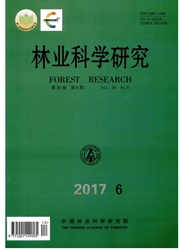

 中文摘要:
中文摘要:
[目的]在宝天曼森林原位建立降水减少(截雨)样地后,样地内的三桠乌药出现了顶端枯死,本研究从水和碳的角度,探讨三桠乌药顶端枯死的原因。[方法]2013年4月在宝天曼锐齿栎林原位建立了3块截雨样地,在2014年生长季干旱时,采用压力室、低压液流系统和蒽酮硫酸法测定了三桠乌药的水力系统特征和非结构性碳等指标。[结果]显示:(1)三桠乌药在截雨处理后出现了顶端枯死;三桠乌药最大导管长度约为60cm,栓塞50%时的水势(P50)为-1.43MPa,其木质部栓塞脆弱性较大。在截雨处理1年后生长季较干旱时,净光合速率、凌晨水势、中午水势显著低于对照,中午栓塞显著高于对照,且水力安全边际为负值。(2)三桠乌药气孔导度、蒸腾速率、叶面积、导管直径、边材比导率、叶片比导率显著下降,Huber值、导管密度显著升高;而叶片、韧皮部、木质部3个器官的可溶性糖、淀粉、总非结构性碳与对照差异不显著。[结论]水力失衡是三桠乌药顶端枯死的主要原因,而蒸腾面积、水分输导系统等的变化表明三桠乌药在缺水环境下进行了一定的适应性调节,但这些调节不足以使三桠乌药在缺水情况下避免水力失衡而导致的顶端枯死。
 英文摘要:
英文摘要:
[ Objective ] The objective of this study is to investigate the reason why Lindera obtusiloba B1. Mus. Bot. in Baotianman Mountain showed dieback based on the perspective of water and carbon. [ Method ] Three rainfall-in- tercepted plots were established at the forest in Baotianman Mountain in April 2013. The hydraulic characteristics and nonstructural carbohydrate of L. obtusiloba were measured during the drought period of August, 2014. [ Re- sult ] ( 1 ) The rainfall reduction caused a lot of shoot dieback of L. obtusiloba. The maximum vessel length of L. obtusiloba was about 60 cm and the water potential causing 50% loss of hydraulic conductivity ( P50 ) was - 1.43 MPa, and thus, the xylem vulnerability to cavitation was very large. After being treated with the interception of rainfall for more than one year, in comparison with the control, the net photosynthetic rate, pre-dawn water potential and midday water potenti',d significantly decreased, the percentage loss of hydraulic conductivity significantly in- creased in the dry period, and terribly its hydraulic safety margin was negative. (2) In addition, the stomatal con-ductance, transpiration rate, leaf area, vessel diameter, sapwood specific conductivity and leaf specific hydraulic conductivity significantly decreased, the Huber value and the vessel density significantly increased compared with the control. However, there were no significant differences in the soluble sugar, starch and total nonstructural car- bohydrate of leaf, phloem and xylem between the rainfall-intercepted trees and the control. [ Conclusion] The re- sults indicate that L. obtusiloba dieback in the rainfall-intercepted plots is attributed to hydraulic failure rather than carbon starvation, and the variation of transpiration area and hydraulic conduction system after treated with rainfall interception indicate that L. obtusiloba has to some degree drought acclimation performances in drought circum- Stance, but the adaptive adjustment is not enough to prevent L. obtusiloba
 同期刊论文项目
同期刊论文项目
 同项目期刊论文
同项目期刊论文
 期刊信息
期刊信息
